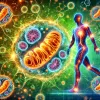Welcome back to our regular feature where we cut through the noise of the thousands of new, health-related papers. We pick a few recent papers and summarize them in a practical and not anxiety-inducing way for people trying to cut through the chatter of fitness influencers.
Our main questions on each paper:
- In simple language, what does it say?
- Does it have good evidence?
- Should what it says matter to normal people?
- What simple thing, if anything, could a normal person do to take advantage of this finding?
Okay, away we go. And under each paper we rate them by practicality and level of interest.
This edition's papers:
- Generative deep learning furthers the understanding of local distributions of fat and muscle on body shape and health using 3D surface scans | Communications Medicine
- Association between change in cardiorespiratory fitness and prostate cancer incidence and mortality in 57 652 Swedish men | British Journal of Sports Medicine
- Dementia in the Ancient Greco-Roman World Was Minimally Mentioned - PubMed
- Pickleball is becoming a full employment act for orthopedic surgeons
Paper 1: Deep Learning and Fat Distribution
Summary
The study uses generative deep learning to analyze the impact of local distributions of fat and muscle on body shape and health through 3D surface scans. This advanced approach offers new insights into how body composition influences individual health outcomes, suggesting a more personalized understanding of health and fitness. The research highlights the potential for using 3D imaging and AI to better understand and address health issues related to body composition.
What does the paper claim?
- It claims that using AI and inexpensive surface scans to analyze the impact of fat and muscle distribution can be a high quality alternative to expensive methods like DEXA scans
Does it have good evidence and methods?
- Yes, it employs advanced analytics and 3D imaging, and its correlation to "gold standard" methods are over 0.7
Does the claim matter to normal people?
- Yes, because are fat distribution plays a large role in human health
- Making it less expensive to get a sense of how and where fat is distributed would be highly useful both in the clinic and at home.
What simple thing could a normal person do to take advantage of knowing this?
- Increase your focus on body composition, especially one's fat percentage and fat distribution
- Recognize there may be new tools coming before long to make this easier and cheaper
Practicality (3/5): 🏃♂️🏃♂️🏃♂️
Interest (4/5): 🏃♂️🏃♂️🏃♂️🏃♂️
Paper 2: Fitness and Prostate Cancer
Summary
The study here examines the relationship between cardiorespiratory fitness changes and prostate cancer risks among Swedish men. It found that increased fitness correlates with lower incidence rates.
What does the paper claim?
- Improved cardiorespiratory fitness is linked to reduced prostate cancer incidence.
- No significant association with mortality was found, which was surprising and contrary to many other studies.
Does it have good evidence and methods?
- Utilizes a prospective cohort design with a large sample from national registers.
- Employs detailed fitness assessments over time, enhancing the study's reliability.
Does the claim matter to normal people?
- Yes, underscores the health benefits of maintaining or improving fitness.
What simple thing could a normal person do to take advantage of knowing this?
- Regularly engage in activities that boost cardiorespiratory fitness, such as walking, running, or cycling.
Practicality (3/5): 🏃♂️🏃♂️🏃♂️
Interest (4/5): 🏃♂️🏃♂️🏃♂️🏃♂️
Paper 3: No Dementia in Antiquity?
Summary
This study analyzes ancient Greco-Roman texts for references to dementia, suggesting its minimal mention might indicate a lower historical prevalence or differing societal perceptions. It contrasts ancient observations with today’s understanding of dementia, exploring potential reasons for its rare documentation in historical records. The paper invites a rethinking of dementia’s historical footprint and its implications for modern societal health.
What does the paper claim?
- Dementia was seldom mentioned in ancient texts, indicating possible lower prevalence or different societal recognition.
Does it have good evidence and methods?
- Utilizes a historical analysis of Greco-Roman literature, offering a unique perspective on dementia’s past prevalence.
Does the claim matter to normal people?
- Sheds light on how dementia was historically understood and recognized, contributing to the broader discourse on aging and cognitive health.
- Opens avenues with respect to environmental factors—air, water, food, etc.—that may play a role.
What simple thing could a normal person do to take advantage of knowing this?
- It makes clear that the current rise in dementia may be historically unusual, and perhaps affected by what we eat, drink, and breathe
- Minimize PM2.5 exposure, avoid microplastics, and eat non-processed foods where possible.
Practicality (3/5): 🏃♂️🏃♂️🏃♂️
Coolness (5/5): 🏃♂️🏃♂️🏃♂️🏃♂️🏃♂️
Paper 4: Pickleball Injuries
Summary
The article here discusses the rising popularity of pickleball and its associated increase in injuries, costing the U.S. healthcare system significantly. It highlights the proactive approach of healthcare providers in forming partnerships with pickleball communities for injury prevention and care, presenting new healthcare opportunities and fostering relationships with players. This initiative benefits both the healthcare system and the pickleball community by addressing the growing need for specialized care.
What does the paper or article claim?
- Rising pickleball injuries present new healthcare opportunities.
- More than half of all injuries are in players over 50..
Does it have good evidence and methods?
- While it cites other studies showing injury data, it is more of an overview of the consequences of pickeball's rise, and how healthcare providers are trying to take advantage of it.
Does the claim matter to normal people?
- Yes, most pickleball players are middle-aged and older, and they are the ones most prone to injuries.
- Benefits healthcare providers looking for new patients, which can be good for normal people, or bad.
What simple thing could a normal person do to take advantage of knowing this?
- Players can get fitter and stronger before they start playing.
- Be cautious about pickleball-specific injury-prevention programs.
Practicality (3/5): 🏃♂️🏃♂️🏃♂️🏃♂️
Coolness (5/5): 🏃♂️
We will be back with more papers next week. And if you see a paper that is getting attention, and you wonder if you should care, let us know.





